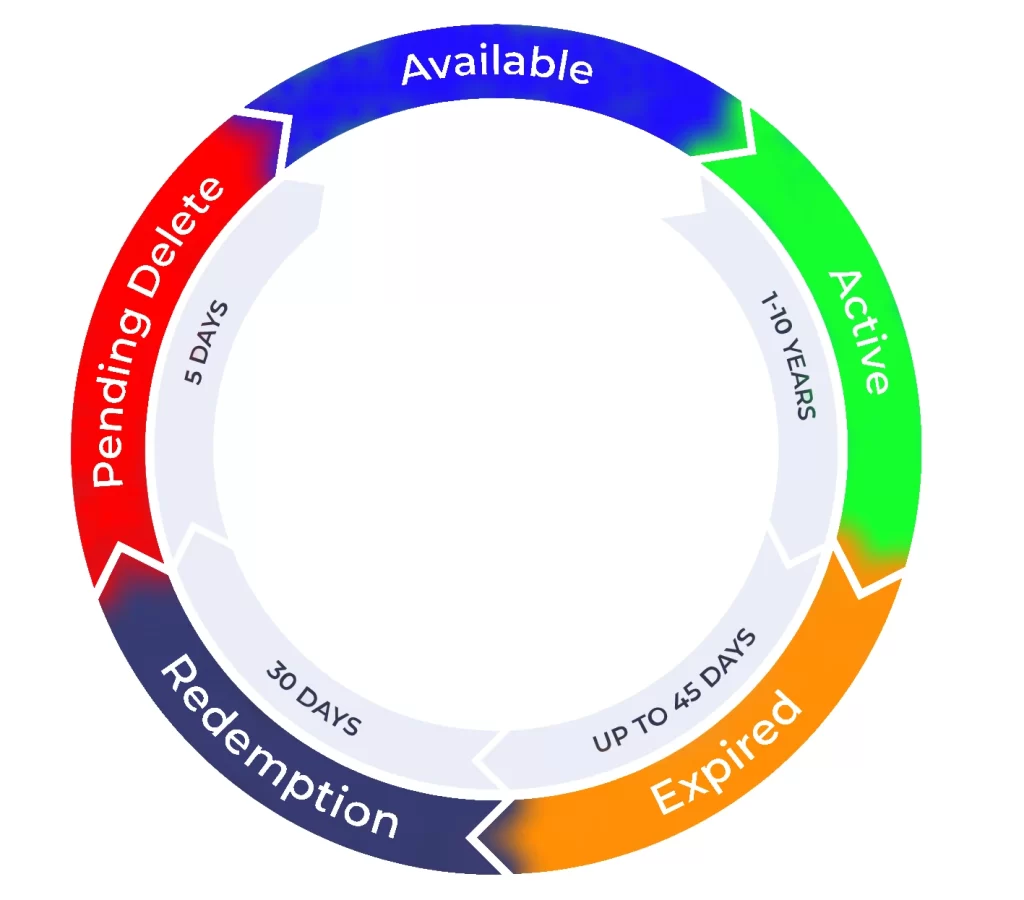Understanding The Life Cycle of a Domain Name
18-01-2024 - BlogsUnderstanding The Life Cycle of a Domain Name
Welcome to our exploration of the life cycle of a domain name. In this blog, we’re going to unpack everything that happens to a domain from the moment it’s first registered to when it might eventually become available again for someone else to use. We’ll start with how these domain names are created, then move on to their everyday use when they’re active. We’ll discuss the necessary steps to hold onto your domain year after year, and what to expect if the domain name expires. Should that happen, we’ll guide you through chances to reclaim it. In the end, we’ll touch on how a domain name goes back into the pool for others to register. So stick around, as we unravel the domain life cycle, from start to finish.
Introduction to Domain Names
Domain names are fundamentally the web addresses you type into your browser to visit websites. They were created to make it easier for us to navigate the internet without having to memorize long strings of numbers known as IP addresses. Every device that connects to the internet has one of these numerical addresses, but just like it is much easier to remember someone’s name rather than their phone number, domain names serve as a memorable shortcut to our favorite online destinations.
At its core, a domain name consists of two main parts: the website name and the domain extension, or what follows after the dot. For instance, in ‘example.com’, ‘example’ is the name, and ‘.com’ is the domain extension. There are many different extensions available, from familiar ones like .com, .org, and .net, to newer or more specific ones like .app, .photography, and even .pizza. This system is managed by a global organization called the Internet Corporation for Assigned Names and Numbers (ICANN).
When you register a domain name, you get the right to use it for a period of time, typically a year, and you can renew it. While the domain is registered to you, no one else can use it. It’s like having a lease on a piece of internet real estate – and during the time you own the domain, you can build a website on it, set up email addresses, or just hold onto it as an investment.
This is just a high-level overview of what domain names are – but if you are interested in delving deeper into the subject, we have a in depth blog post called “What is a domain“.

The Availability Period – The Birth of a Domain
The birth of a domain name is a straightforward yet pivotal process in establishing an online presence. And it all begins with a unique idea, a distinctive name that will represent you, your business, or your project on the internet. This name must be one that has not been previously claimed by someone else, or at least currently not active – to ensure uniqueness, every domain name can only be registered to one entity at any given time.
Registration is the first official step in the lifecycle of a domain name. You start by brainstorming possible domain names and then check if they are available – this is done through a registrar, a service that allows you to register and manage domain names. In the early days of the internet, their was only a handful of domain registrars – but now? in 2024? the list of domain registrar just keeps going on – just to name a few:
Once you find a name that is available and suits your needs, you will go through the registrar’s process to claim it – this typically involves choosing the length of time you want to register the domain, which can range from one year to multiple years in advance. During registration, you’ll be asked to provide contact information and possibly decide on privacy options for your domain records, which can otherwise be publicly accessed.
After paying the registration fee, the chosen domain name is yours. The domain is entered into a global database, which is updated across the internet to reflect that the name has now been taken. What follows is often a flurry of activity: setting up a website, creating custom email addresses, and announcing your new digital address to the world. But bear in mind that the registration of a domain doesn’t imply ownership, so much as a temporary lease – with the exclusive rights to use that specific web address for the duration of the registration period.
The Active Period – Active Use and Management
Once a domain name is registered, it transitions into an active state. This is when the domain name is not just a placeholder but becomes a live wire to the internet, ready to be connected to a website and email services. But having a domain isn’t just about getting it up and running; it’s also about keeping it secure and managing it effectively. During its active period, you – the domain owner – have various options and “responsibilities”.
Connecting Your Domain to a Website
To make your domain lead to an actual website, you need to set up web hosting and link the two. This involves changing the domain’s DNS (Domain Name System) settings to point to your web host’s servers. Think of DNS as the internet’s phonebook, directing traffic that comes to your domain to the right server where your website lives.
Creating Email Addresses
With a domain name, you can create custom email addresses (like yourname@yourdomain.com), which can lend professionalism to your correspondence.
Security
It’s crucial to ensure your domain remains secure. This means keeping your registration details up to date, renewing your domain before it expires to prevent loss of service or domain hijacking, and considering additional security measures like domain privacy (which keeps your personal information out of public view) and SSL certificates (which encrypt data exchanged between your site and its visitors).
Management and Maintenance
Active domain management also involves monitoring for any unauthorized changes to your domain’s DNS settings, renewing your domain, and making sure all related accounts (like your registrar and hosting accounts) are secured with strong passwords and two-factor authentication where possible.
Optimization and Analytics
You might want to set up analytics to track the traffic coming to your website and monitor the performance of your online projects. This can help you understand your audience better and refine your services or content accordingly.
Compliance
It’s essential to comply with any legal requirements for your website content, data handling, and business practices. Failure to comply can result in your domain getting suspended.
During the active phase, your domain name is more than a static address; it’s an evolving entity that reflects your engagement with the online world. Managing it effectively ensures your site remains accessible, your communication stays professional, and your online presence continues to grow securely and robustly.
The Expired Period
The “Expired Period” follows the active life of a domain name, where the registration has lapsed due to non-renewal. It marks a critical transition phase and presents a series of consequences and critical actions for domain registrants.
Service Interruption
As soon as your domain name expires, the services associated with it are typically suspended. If you have a website linked to this domain, it becomes unreachable, and any email addresses under the domain stop receiving messages. This can result in loss of communication, missed opportunities, and a diminished online presence.
Visibility in WHOIS Database
An expired domain’s status is updated in the WHOIS database, a public directory that lists the registration and expiration dates of domain names. This status change signals to potential domain buyers that the domain may soon be available for purchase.
Renewal Attempts
During the initial days of the Expired Period, the original domain registrants still have an opportunity to renew their domain name. However, the process may involve late renewal fees over and above the normal renewal rates.
Lost to New Registrants
If the current registrant does not renew the domain before the end of the auction process, and if the domain is successfully auctioned, the ownership will then pass to the highest bidder.
Grace Period Consideration
Not all is lost immediately after a domain expires. Registrars typically offer a grace period – a window of time post-expiration – affording the owner a last chance to renew without the immediate threat of losing their domain to new buyers.
Auction Process
If a domain name carries value – whether in terms of its traffic, generic appeal, or brand potential – it may be listed for auction by the registrar during the Expired Period. Interested buyers can bid on the domain, in the hope of acquiring it should the original owner fail to renew.
It’s important to note, however, that the specific rules governing the Expired Period, including the length of the grace period and the fees involved, can differ between registrars and might also depend on the domain extension. As such, understanding the specific terms of your registrar’s service agreement is vital to navigate the Expired Period effectively. The Expired Period starts the countdown for original domain owners to make decisions on renewal and for potential new owners to stake their claim. It’s a time when the future of the domain is up in the air, dependent upon the actions – or inaction’s – of those who value it.
The Redemption-/Grace-Period
The “Redemption Period,” or as it is often referred as, the “Grace Period,” – is a specific interval in the domain life cycle, offering a safety net for registrants who have let their domain name expire. This stage serves as the penultimate opportunity to reclaim an expired domain before it is completely purged from the registrar’s database and potentially captured by another interested party. All you need to know about the Redemption-/Grace-Period:
Length of the Period
Typically extending from 30 to 90 days after the domain’s expiration date, this period’s exact duration can vary greatly depending on the registrar’s policies and the top-level domain (TLD). During this time frame, the original domain owner still has the exclusive right to renew their domain name.
Domain Status
During the Redemption Period, the domain name is put on hold and all services related to the domain (website, email, etc.) remain inoperable. The domain’s WHOIS record often reflects a “RedemptionPeriod” status, signaling that the domain is in this transitional stage.
Increased Renewal Cost
Renewing a domain name during the Redemption Period typically incurs additional fees. These fees are often much higher than the standard renewal price due to the extra steps involved for the registrar to retrieve the domain name from its expired status and reinstate it to the domain owner.
Prevention of Domain Sniping
This period serves as a protective measure against domain sniping, where third parties attempt to register a recently expired domain. It ensures that the original domain owners have enough time to rectify any oversight and renew their domain before it goes up for grabs to the public.
Restoration Process
To recover a domain during this phase, the domain owner must contact their registrar and request a restoration. The process may require the owner to validate their identity to proceed with the renewal and payment of associated fees.
It’s key for domain owners to understand that the Redemption Period is the last definitive chance to regain ownership of a domain before it is released for re-registration to the general public. To avoid complications or loss of a valued domain, it is often recommended to set up automatic renewals and to keep contact information current with the domain registrar. However, in case these measures fail or are not in place, the Redemption or Grace Period offers a final buffer to correct the situation and maintain continuity of the online presence associated with the domain name.
The Pending Deletion Period
“The Pending Deletion Period” is a brief yet critical phase in the life cycle of a domain name, marking the final stage before it is released back into the pool of available domain names. This stage comes after the domain has expired and the subsequent Redemption or Grace Period has passed without the registrant renewing the domain. Here’s what you need to know about the Pending Deletion Period:
The Point of no Return
At this point, the domain name is beyond the reach of the original owner. Once a domain enters the Pending Deletion status, it cannot be restored or renewed by any means. Essentially, this is the period where the domain name awaits its removal from the registrar’s database.
The Time frame
The Pending Deletion period typically lasts for five days. During this time, the domain is effectively in limbo – it is no longer active, and the registrar has flagged it for removal from its records.
Automated Deletion Process
After the Pending Deletion period concludes, the domain name is automatically deleted from the registrar’s database, which then triggers an update in the global domain name system, indicating that the domain is now available again for registration.
Domain Name Availability
Once the domain name has been deleted, it becomes available for anyone to register on a first-come, first-served basis. This opens opportunities for new registrants to acquire valuable domain names that were previously owned but have gone through the full expiry cycle without renewal.
The Pending Deletion period serves as a definitive endpoint for expired domains, concluding the process that started with the domain’s expiration. As the domain enters this final countdown, interested parties may monitor the status, preparing to attempt registration as soon as the domain is released. It’s a period characterized by both closure for some and anticipation for others, as the domain prepares to embark on a new chapter with a potentially new owner. For those keen on capturing such domains, various services and platforms track these expiration cycles, providing tools and alerts to capitalize on the moment when the domain becomes available.
Understanding the End of the Registration Period – to secure your domain
When you register a domain name, it’s important to remember that this registration isn’t indefinite – it’s more like a renewable lease. Each domain is registered for a set period, usually between one to ten years, depending on the options you chose at the time of purchase. At the end of this period, the domain name reaches what we call expiration. Expiration of a domain doesn’t occur without warning. As the end of the registration period draws near, your registrar will typically send multiple reminders, urging you to renew your domain. Failing to renew a domain has consequences
Website and Email Disruption
Once your domain expires, any services associated with it, like your website and email, will stop working. This means customers or visitors won’t be able to find you or contact you through those channels.
Redemption Period
Some registrars offer a grace period after expiration, known as a “redemption period,” during which you can still renew the domain, although there might be an additional fee. However, after this period, the domain could be auctioned off to new potential owners.
Release to the Public
If the domain is not renewed or purchased during the redemption period, it will eventually be released back to the public, making it available for anyone to register.

Losing a domain name due to non-renewal can be more than an inconvenience – it can be a significant setback for your business or personal brand. Your search engine rankings can plummet, and once-loyal visitors might turn to competitors or alternatives. Moreover, if your domain has a high SEO value or is particularly desirable, domain prospectors might be waiting to snap it up the moment it becomes available.
To avoid these pitfalls, it’s essential to keep track of your domain’s expiration date and renew it in a timely fashion. Most registrars allow you to set up automatic renewals, which can ensure your domain remains in your possession without you having to remember to manually renew it each term. It’s also wise to keep your contact information up to date, so you don’t miss any critical notifications about your domain’s status.
